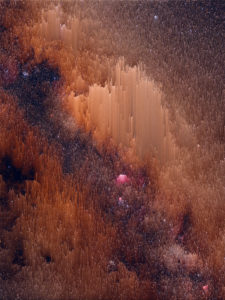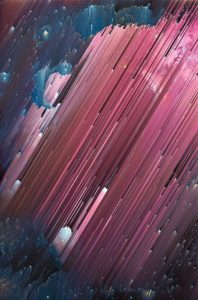Adam Ferriss is a digital artist based in Los Angeles; he studied photography at the Maryland Institute College of Art where he became interested in using code to manipulate his photos. Later he received his MFA from UCLA. He experiments with RGB tricolor separation, shader programs, and pixel sorting algorithms. When Ferriss first started to manipulate photos, he took black and white photos and added red, green, and blue filters. He started incorporating code by exploring and experimenting in processing; he studied using Daniel Shiffman’s Nature of Code and Learning Processing.
Ferriss creates these psychedelic and optical illusions using photoshop, Adobe After Effects, and putting the photo through an algorithm to distort the pixels. The technical tools he frequently uses are: openFrameworks, GLSL, and Javascript. In an interview with Software Development Times, Ferris explains how he alters the color and movement of the pixels: “I work a lot with noise functions, Perlin noise, or simplex noise. They’re ways to generate pseudo-randomness in color, like shaping form. It generates a seed pixel, and from that one seed pixel it looks out at its neighbors, and continuously expands so its neighbors will start expanding. It’s essentially like you’re growing an image or a crystal in the way it clumps itself together and generatively expands.”
In interviews, Ferriss talks about how he takes inspiration from around him. He finds code that is already out there (he describes searching around GitHub) and then tinkering with it. He changes variables and runs the code over and over again until he sees something he likes.
Before earning his MFA from UCLA, Ferriss ran the photo lab at Otis College of Art and Design.He has also worked with companies such as the New York Times, Google, and Nike and has been featured on Wired, the Creators Project, Fast Company and many others.


I think my favorite pieces are from his collection called “500 Years Away”; the visuals are futuristic and parallel what I imagine space to look like.
Ferris also explores interactive art; on his website he has shared pieces where the user can control what happens. For example: https://adamferriss.com/seeds/

It’s so cool how Ferriss takes an image or video and creates an amazing optical effect by just changing the color or the pixels. I agree with you that his pieces from “500 Years Away” are really brilliant. I think it’s also great how you discussed his actual process, taking inspiration from others and manipulating pre-existing code.
One thing that I like about Adam’s work is that there’s a clear execution in the work. It’s not overburdened with too much image processing or so much visual information that it gets distracting. By leveraging existing algorithms, he can think more about the “why” than the “how”.
I really like the way he utilizes color and pixel manipulation to generate a completely new meaning through the medium he is showing. In some aspects it has a vapor wave feel to it and in other like the “500 Years Away” piece, it feels like a piece of nature even though it is heavily edited.
I like how his work is an intersection of code and more traditional mediums like photoshop or after effects. I really enjoyed his interactive piece you included at the end of your post; it’s amazing how he manipulates colors and pixels.
I was really intrigued by the video of the waves crashing. Adam Ferriss has a different background than other artist in this field, studying photography. I think that made a big difference between his works and others, focusing on color and developing an actual picture to something completely new and cool.
I think it’s really inspiring that he shares how he learned how to do what he does, and that he searches GitHub to find existing code to modify. It shows a humility and transparency that you don’t often see when people begin to get recognition. They usually pretend like they just magically know all of the things they know, or create everything with ease, however his process is one we all can do.
Nice post! I think it’s cool how Farriss uses existing code, messes with it, and makes it his own. I also love how he uses both coding as Adobe programs to create his artwork.
Randomness and photography has always been such a interesting combination to me. The waves look so surreal in this case and beautiful!
Ferriss’s works are very related to what we do in class, playing around with already existing code and randomness. The interactive artwork was very cool in that the viewer is creating their own art by using the mouse and keyboard. You talk about how Ferriss uses noise function in his works. I’ve seen many people use noise in their tutorial video, but I never got the chance to learn exactly what it does. It would be nice if you can talk about it during your presentation or I should just go look it up.